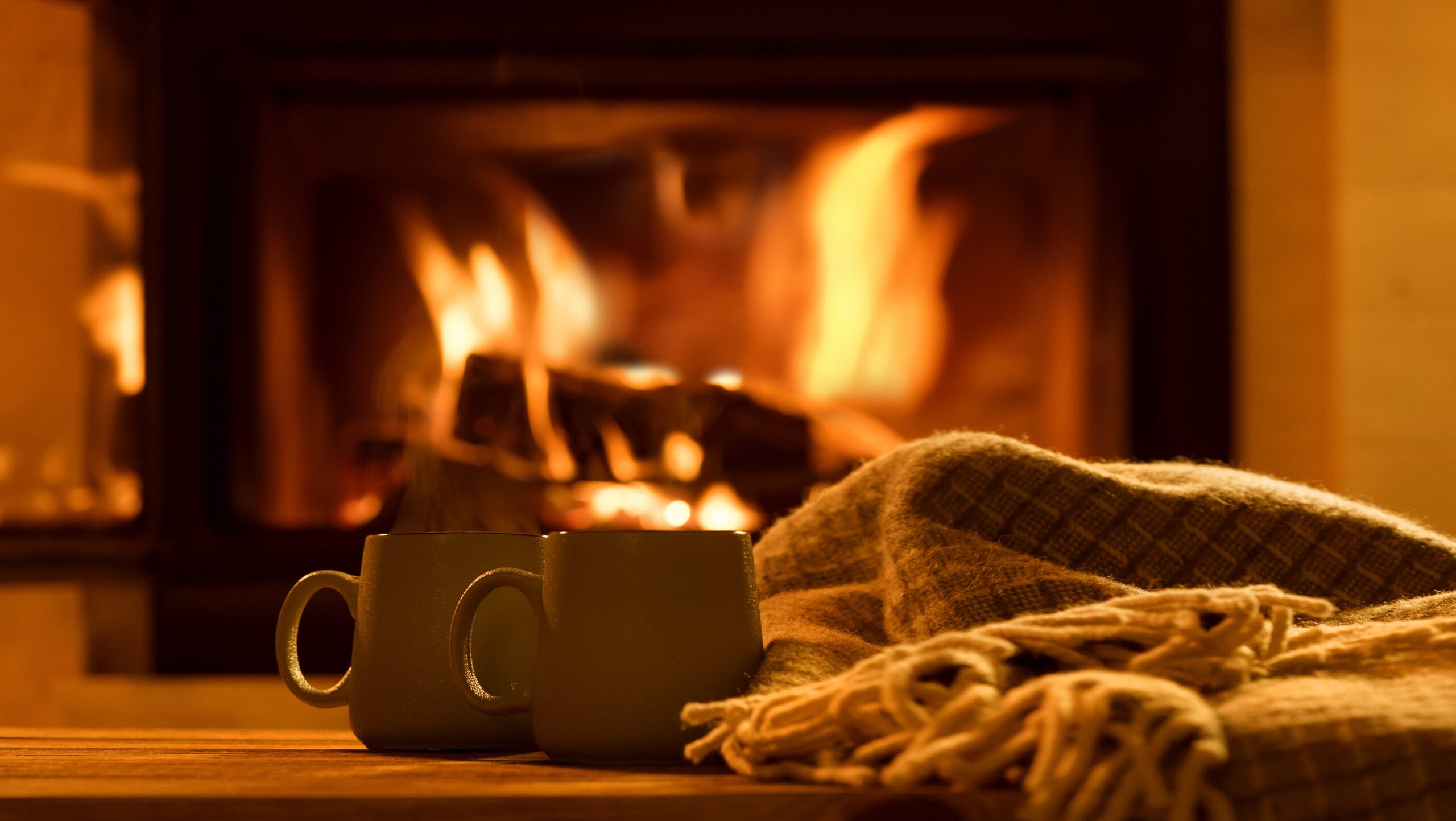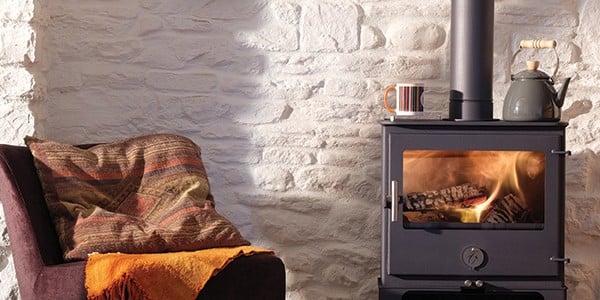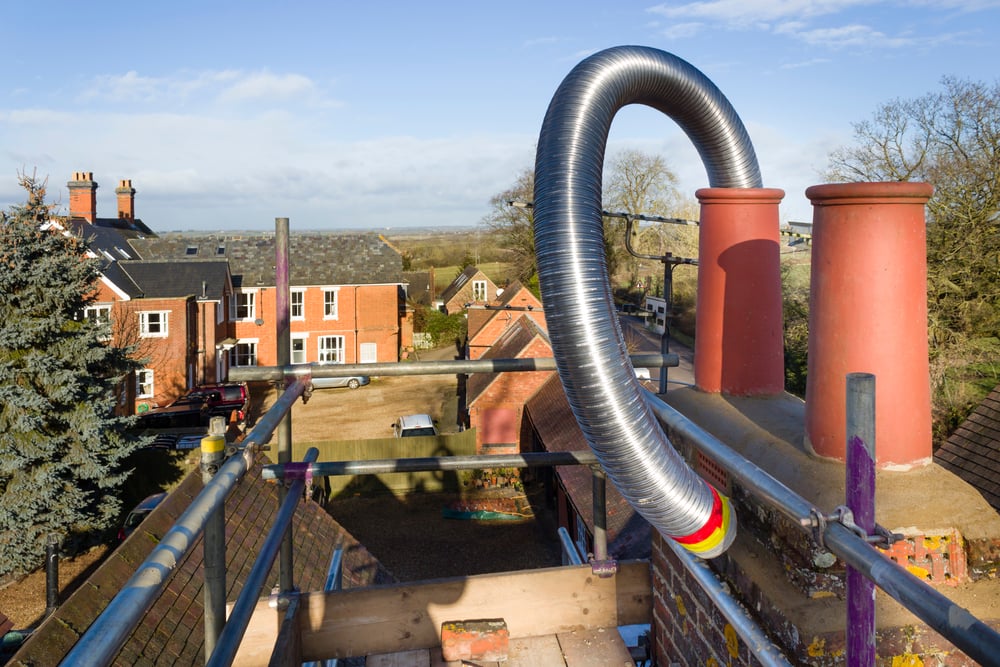Why does my wood burner smell?
Part of the aesthetic of your wood burner is the cosy fireplace smell – this familiar smell is not something to worry about! However, your stove may require investigation if it has started producing odours that are new, stronger than usual, or out of place. Not all smells are signs of major problems – the age of your stove, weather, and environment all affect the smell produced when burning.
Sooty, chemical, or rotten smells can be a sign of issues in your chimney; if your wood burner is emitting concerning odours, contact your local HETAS Approved Servicing Technician to arrange an inspection.
Types of smells and their causes
Strong smoke smell
There are a number of reasons that your wood burner could be emitting an excessively strong smoke smell:
- You are burning wet wood – burning wood with a high moisture content causes the excess moisture to burn and produce large amounts of smoke. By burning Ready to Burn wood, there will be much less smoke produced and a vast reduction in the smoke smell in your property.
- Your fire is getting insufficient airflow – burning with insufficient airflow starves your fire of oxygen, leading to slow-burning. Slow-burning causes more smoke to be emitted through a less clean and less efficient burn.
- Your fire is not burning at a high enough temperature – the optimum temperature for your fire varies depending on your appliance. Check the manufacturer’s guidance to find what temperature is ideal for your appliance and aim to burn at this temperature. Burning at too low a temperature can lead to incomplete combustion, producing excessive smoke and other hazards.
- Your chimney or flue is blocked – if you can smell soot or creosote in addition to smoke, it is likely that there is a blockage in your chimney or flue. Book a chimney sweep with your local HETAS Approved Chimney Sweep as soon as possible to avoid the potential of a chimney fire or carbon monoxide poisoning.
- Inadequate chimney size – if your chimney is not suitable for your appliance (for example, it is too short or not wide enough) it could be providing insufficient draw to fully remove smoke from your property. This smoke would then re-enter, causing a lingering smoke smell. If you believe your chimney is not suitable for your appliance, contact a HETAS Approved Servicing Technician to investigate and provide trusted advice.
- Insufficient ventilation – negative air pressure due to insufficient ventilation can lead to difficulties starting a fire or smoke re-entering the room. Providing ample ventilation through open doors, windows left ajar, and opening any vents in your property helps prevent negative air pressure.
- Closed damper – accidentally leaving your stove damper closed whilst your stove is in use causes your fire to get insufficient airflow. Keeping your damper open to promote oxygen flow to your stove helps keep your fire burning. Your damper should only be closed once the fire is out and your appliance has sufficiently cooled down – this will prevent strong smoke smells in your home.
- Damaged appliance – if your appliance is damaged, it could be leaking smoke as you burn. Check your door seals and your stove glass for issues to ensure that your appliance is not leaking smoke.
Soot smell
A strong smell of soot when your wood burner is in use is a telltale sign that your chimney requires sweeping. Soot is a by-product of burning wood – burning Ready to Burn logs with a moisture content of 20% or less reduces the production of soot, but over extended periods soot can still build up in your chimney. If you smell a strong soot smell when burning, book a HETAS Approved Chimney Sweep to investigate and eliminate any soot deposits.
Paint smell
If you notice a paint smell when using your stove, this is likely due to the paint on your wood burner still needing to cure. Paint curing is the process in which paint becomes fully hardened, following drying.
A paint smell occurs most often on new stoves where the fresh coat of paint is still curing. If you notice this smell, follow these steps to eliminate it:
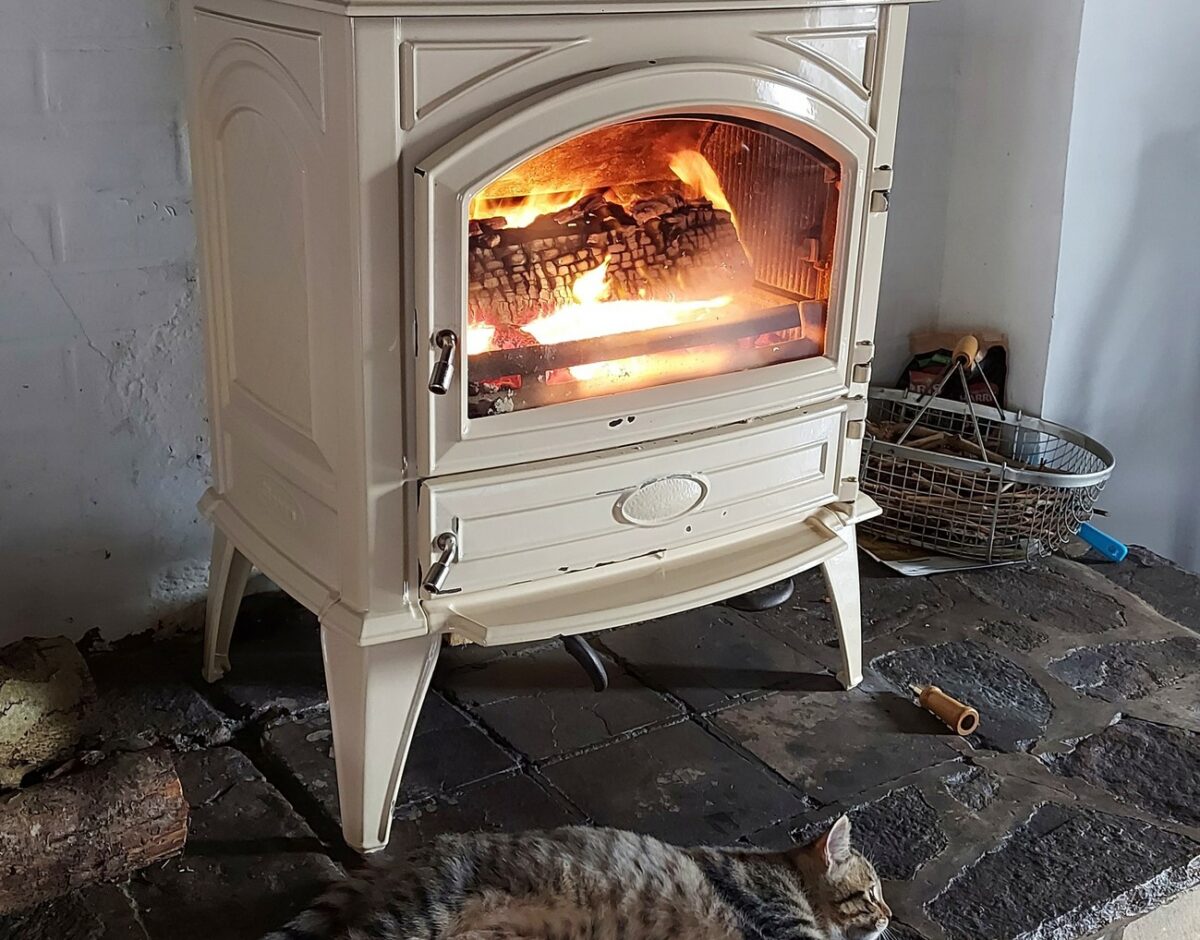
- Start a small fire, slowly building it and increasing the heat over a 4-6 hour period. Keep the room well ventilated.
- Repeat this process with larger, hotter fires until the paint smell has dissipated. The paint smell should take 3-4 burns to eliminate, with the smell reducing with each burn.
If the smell persists after following these steps, it is possible that some paint is burning further up in your flue system. It is a good idea to schedule a chimney inspection and sweep if the smell is persistently strong.
Chemical and medicinal smell
Creosote build-up causes a pungent smell that is often described as chemical and medicinal – when burning, the smell resembles burnt tar or asphalt. Creosote is a highly flammable substance that can build-up in your chimney, creating a major risk of a chimney fire. If you smell a strong tar smell when using your log burner, it is highly advisable to turn your appliance off and book a chimney sweep as soon as possible.
Rotten or foul smell
If you smell a putrid odour when using your wood burner, it is possible that there is the corpse of an animal trapped in your chimney. This smell will continue to get worse the more you burn so it is recommended that you book a chimney sweep to eliminate the corpse and the smell so you can continue burning.
Ash smell
Ash left too long and in too large quantities in your wood burner can emit a strong ash smell; if you smell ash when burning then it is time to clear it out. Excess ash also reduces the airflow to your stove, leading to poorer burning and increased smoke.
Stale or damp smell
A stale or damp odour from your stove often occurs due to a build-up of moisture in your chimney. The most common cause of moisture build-up is burning wet wood; ensure you are burning Ready to Burn wood with a moisture content of 20% or less to avoid a build-up of moisture, soot, and creosote in your chimney.
How to stop your wood burning stove from smelling
- Burn Ready to Burn wood – firewood with a moisture content of 20% or less burns cleaner and more efficiently.
- Have your chimney swept at least twice a year – keeping your chimney clear of soot, tar, and creosote deposits aids a clean and safe burn.
- Ensure that your room is adequately ventilated; a healthy burn needs a healthy supply of oxygen.
- If your stove is new, use it a few times (burning hotter each time) to eliminate any paint smells.
- Dusting down your stove if it hasn’t been used for a prolonged period prevents the dust from burning and emitting an odour as you use your stove.
- Check your stove – if your door seals or stove glass are damaged, smoke can leak into your property causing lingering odours.
Burning clean, safe, and efficiently
Always ensure you are burning wood with a moisture content of 20% or less. Using a moisture meter to measure your firewood moisture content ensures that your logs are ready for a clean and efficient burn. Burning wet wood is the most common cause of excess smoke and smells entering your home.
Your stored wood can slowly soak up fumes from other sources
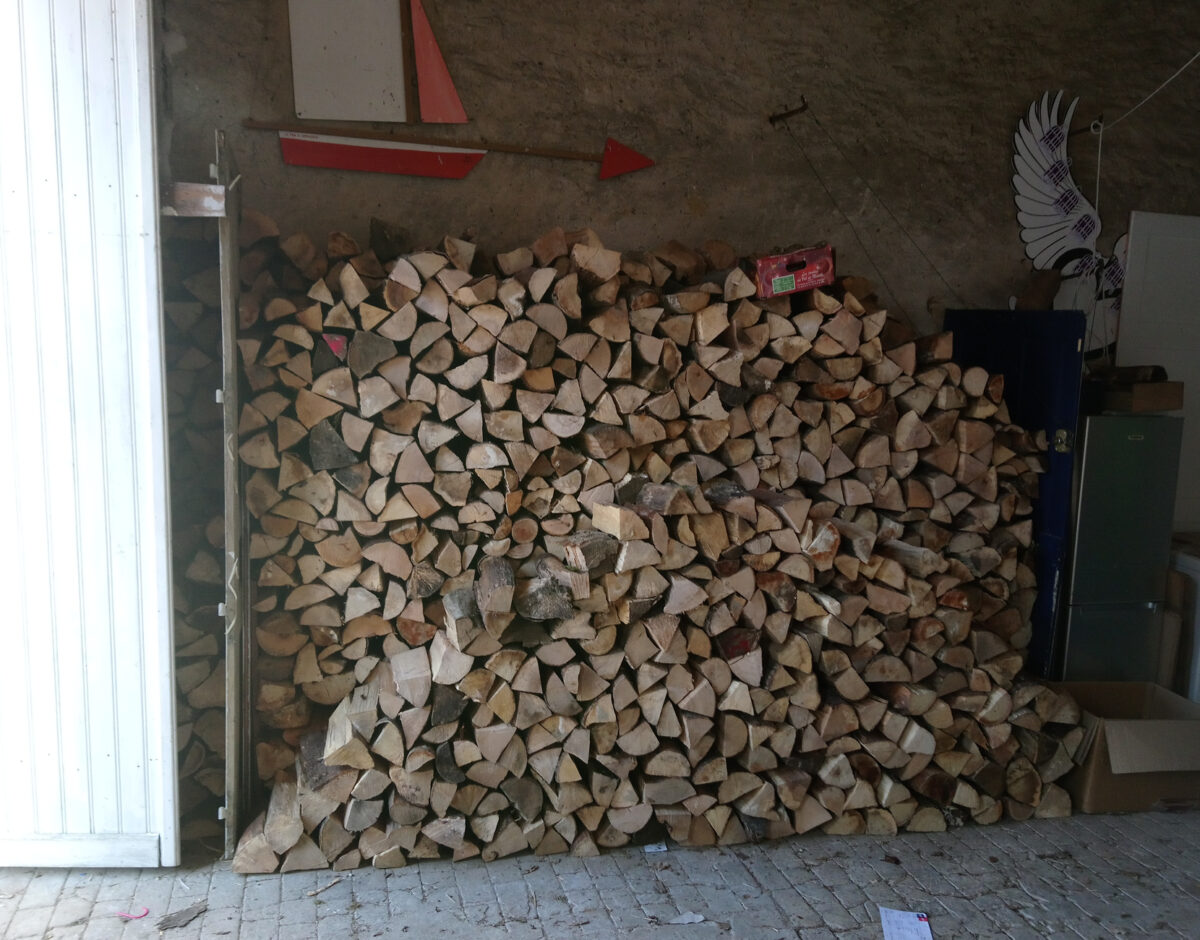
If you store your wood in your garage, over a period of time it can absorb fumes and odours from your vehicle. Residual exhaust fumes can be absorbed, causing your logs to give off a faint smell when burned. Whilst this isn’t a cause for concern due to the extremely low concentration of exhaust fumes present in the wood, the smell isn’t desirable.
To avoid your wood smelling like exhaust fumes, prioritise the wood at the bottom of your log store when selecting logs to burn or, if possible, store your logs in another suitable location.
If you are unsure whether your wood or your appliance is causing an unpleasant odour, burn wood that has been stored separately – this will identify whether the culprit is your wood supply or your appliance.
There are other issues to be wary of as not all problems have noticeable odours. For example, carbon monoxide is an odourless, colourless gas that can major health issues, even death. For more information carbon monoxide safety, see our carbon monoxide safety advice.
Booking a HETAS Approved Chimney Sweep prevents your wood burner from smelling by keeping your chimney clear of any deposits or debris. A swept chimney is a safe chimney – build-up of soot, tar, and creosote can lead to chimney fires and carbon monoxide poisoning.
